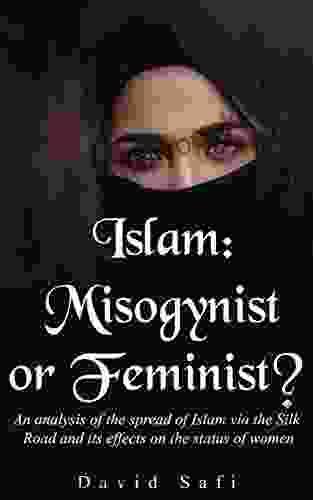Unveiling the Silk Road's Impact: The Expansion of Islam and Its Profound Legacy

The Silk Road, a sprawling network of interconnected trade routes, played a pivotal role in shaping the fabric of civilization for centuries. Its intricate pathways not only facilitated the exchange of goods and ideas but also became a catalyst for the dissemination of religious beliefs. Among the religions that found fertile ground along the Silk Road, Islam stands out as a particularly influential force, leaving an enduring mark on the regions it touched. This article delves into the complex and multifaceted ways in which Islam spread along the Silk Road, examining its causes, methods, and profound effects on the societies it encountered.
The Allure of Islam
The appeal of Islam in a pre-Islamic world can be attributed to a confluence of factors. Monotheistic in nature, Islam offered a compelling alternative to the polytheistic beliefs prevalent in many societies along the Silk Road. Its message of social justice, equality, and a direct relationship with God resonated deeply with many who sought meaning and purpose in an often chaotic world. Moreover, Islam's emphasis on trade and commerce aligned with the Silk Road's economic realities, making it attractive to merchants and traders.
5 out of 5
| Language | : | English |
| File size | : | 151 KB |
| Text-to-Speech | : | Enabled |
| Screen Reader | : | Supported |
| Enhanced typesetting | : | Enabled |
| Word Wise | : | Enabled |
| Print length | : | 20 pages |
| Lending | : | Enabled |
Modes of Transmission
Islam spread along the Silk Road through a combination of peaceful and military conquests, as well as through the efforts of merchants, travelers, and missionaries.
- Conquests: Arab armies expanded the reach of Islam through a series of military campaigns, conquering vast territories from the Iberian Peninsula to the bFree Downloads of China. These conquests established Islamic empires and brought Islam to new regions, including Central Asia, Persia, and North Africa. - Trade: The Silk Road's vibrant trade networks provided an avenue for the spread of Islam. Merchants and traders carried not only goods but also ideas and beliefs, exposing non-Muslims to Islamic teachings and practices. - Travel: The Silk Road facilitated the movement of people from different backgrounds and cultures. Pilgrims, scholars, and mystics traveled along its routes, sharing their knowledge and beliefs, and contributing to the dissemination of Islam. - Missionaries: Islamic missionaries played a crucial role in spreading the faith, traveling far and wide to preach the message of Islam. They established schools and centers of learning, translating Islamic texts and engaging in religious debates.
Effects on Society
The spread of Islam along the Silk Road had profound and lasting effects on the societies it touched:
- Religious Transformation: Islam became the dominant religion in many regions along the Silk Road, replacing or coexisting with existing religious practices. It brought about a shift in religious beliefs, practices, and rituals, introducing new concepts of God, worship, and morality. - Cultural Exchange: The Silk Road became a melting pot of cultures, where Islamic ideas and practices blended with those of indigenous societies. This exchange resulted in a rich tapestry of artistic, architectural, and literary expressions that showcased the fusion of different traditions. - Economic Impact: Islam influenced economic practices along the Silk Road, promoting trade and commerce. The establishment of Islamic empires created a unified economic zone, facilitating the flow of goods and services and fostering economic growth. - Social Change: Islam brought about social reforms, promoting equality and social justice. It challenged existing social hierarchies and established new social norms, advocating for the rights of women and the less fortunate. - Intellectual Flourishing: The spread of Islam led to the establishment of centers of learning and scholarship along the Silk Road. These institutions became hubs of intellectual inquiry, fostering the development of philosophy, science, and the arts.
Case Studies
To illustrate the complex and multifaceted ways in which Islam spread along the Silk Road, let us examine three case studies:
1. Central Asia
Central Asia became a major center of Islamic civilization. Arab armies conquered the region in the 7th century, establishing the Umayyad Caliphate. Over time, local rulers adopted Islam and established their own dynasties, such as the Samanids and the Ghaznavids. These dynasties played a key role in patronizing Islamic scholarship and culture, making Central Asia a hub of learning and artistic achievement.
2. Persia
Persia (modern-day Iran) had a long history of interaction with Islam. Following the Arab conquest in the 7th century, Persia gradually became Islamized. However, Persian culture exerted a significant influence on the development of Islam in the region, leading to the emergence of Shi'a Islam, a distinct branch of Islam with its own unique beliefs and practices.
3. China
Islam arrived in China through Silk Road trade routes in the 7th century. Initially, it gained a foothold among foreign merchants and communities. Over time, Islam spread to the wider Chinese population, particularly in the northwest. Chinese Muslims, known as the Hui, adopted Chinese customs while maintaining their Islamic faith, creating a unique blend of cultures and traditions.
The spread of Islam along the Silk Road was a complex and transformative process that shaped the religious, cultural, and social landscapes of the regions it touched. Through a combination of peaceful and military conquests, trade, travel, and missionary work, Islam became a dominant force along the Silk Road, leaving an enduring legacy that continues to this day. The Silk Road served as a conduit for the exchange of not only goods but also ideas, beliefs, and cultures, contributing to the rich tapestry of human civilization.
5 out of 5
| Language | : | English |
| File size | : | 151 KB |
| Text-to-Speech | : | Enabled |
| Screen Reader | : | Supported |
| Enhanced typesetting | : | Enabled |
| Word Wise | : | Enabled |
| Print length | : | 20 pages |
| Lending | : | Enabled |
Do you want to contribute by writing guest posts on this blog?
Please contact us and send us a resume of previous articles that you have written.
 Book
Book Novel
Novel Page
Page Chapter
Chapter Text
Text Story
Story Genre
Genre Reader
Reader Library
Library Paperback
Paperback E-book
E-book Magazine
Magazine Newspaper
Newspaper Paragraph
Paragraph Sentence
Sentence Bookmark
Bookmark Shelf
Shelf Glossary
Glossary Bibliography
Bibliography Foreword
Foreword Preface
Preface Synopsis
Synopsis Annotation
Annotation Footnote
Footnote Manuscript
Manuscript Scroll
Scroll Codex
Codex Tome
Tome Bestseller
Bestseller Classics
Classics Library card
Library card Narrative
Narrative Biography
Biography Autobiography
Autobiography Memoir
Memoir Reference
Reference Encyclopedia
Encyclopedia David Pond
David Pond Dennis W Thomas
Dennis W Thomas Devatma Saraswati
Devatma Saraswati Dawna Stone
Dawna Stone David Zeltser
David Zeltser David Wolff
David Wolff David Clowes
David Clowes Derek Schauland
Derek Schauland Deborah Daw Heffernan
Deborah Daw Heffernan Darcel Smart
Darcel Smart Dave Candy
Dave Candy David Castle
David Castle David Mandel
David Mandel David B Morris
David B Morris Deniz Aydoslu
Deniz Aydoslu Diana Johnson
Diana Johnson Dara Horn
Dara Horn Diana Leagh Matthews
Diana Leagh Matthews David Jones
David Jones Danielle Marietta
Danielle Marietta
Light bulbAdvertise smarter! Our strategic ad space ensures maximum exposure. Reserve your spot today!

 Floyd PowellSecret Of Seed Bija Mantras: Unveiling the Healing Power of Nature's Sacred...
Floyd PowellSecret Of Seed Bija Mantras: Unveiling the Healing Power of Nature's Sacred...
 Benji PowellUnveil the Mystery of the Annunciation: A Journey through "The Twelve Great...
Benji PowellUnveil the Mystery of the Annunciation: A Journey through "The Twelve Great... Craig CarterFollow ·14k
Craig CarterFollow ·14k Bryan GrayFollow ·6.8k
Bryan GrayFollow ·6.8k Quentin PowellFollow ·4.8k
Quentin PowellFollow ·4.8k Doug PriceFollow ·5.4k
Doug PriceFollow ·5.4k Manuel ButlerFollow ·7.2k
Manuel ButlerFollow ·7.2k Eric HayesFollow ·6.9k
Eric HayesFollow ·6.9k W. Somerset MaughamFollow ·9.9k
W. Somerset MaughamFollow ·9.9k Cruz SimmonsFollow ·17.4k
Cruz SimmonsFollow ·17.4k

 Tyler Nelson
Tyler NelsonThe Canyoneer Trail Guide To San Diego Outdoors
Are you ready to embark on an...

 Noah Blair
Noah BlairMocktail Party: The Perfect Book for Your Next Party!
Looking for a fun and easy way to entertain...

 Garrett Bell
Garrett BellFast Seafood: Easy, Healthy Seafood Recipes for Every Day
Seafood is a delicious and healthy...

 Ivan Turner
Ivan Turner90 Breath Prayers For The Activity Professional
Just A Closer...

 Charles Reed
Charles ReedCommunication Documentation And Insurance Billing For...
Unlock the...
5 out of 5
| Language | : | English |
| File size | : | 151 KB |
| Text-to-Speech | : | Enabled |
| Screen Reader | : | Supported |
| Enhanced typesetting | : | Enabled |
| Word Wise | : | Enabled |
| Print length | : | 20 pages |
| Lending | : | Enabled |










